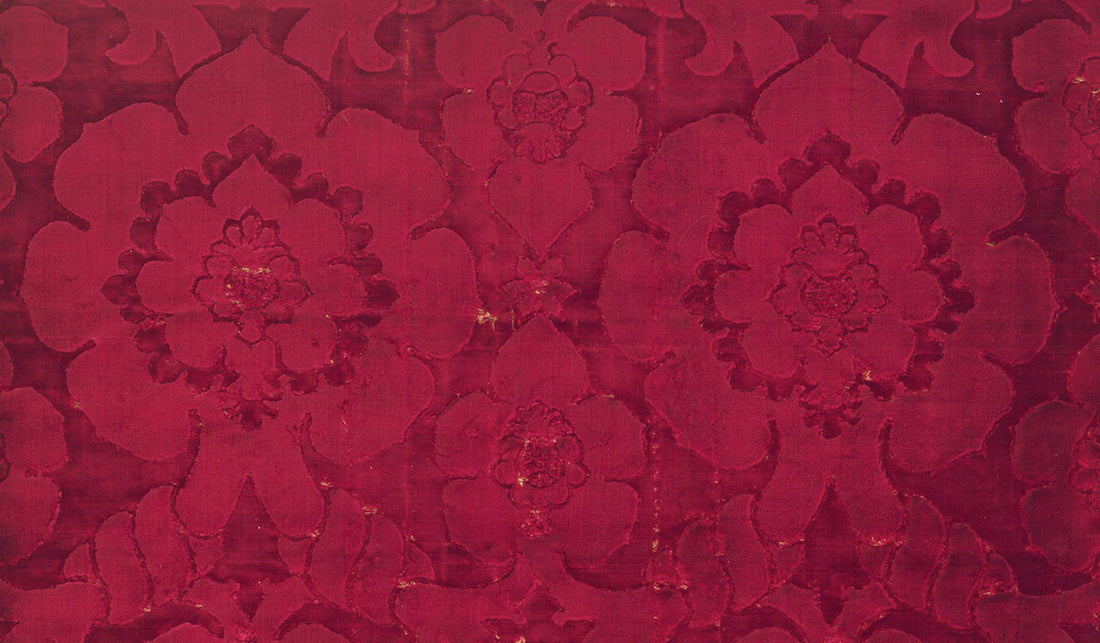
Sumptuous Velvets
Velvet has always been a luxurious fabric, and only available to the wealthy until quite recently. Sumptuously soft to the touch and gloriously reflecting light when it moves, it's easy to see why it has such appeal. Throughout most of its existence velvet has been as a symbol of power; velvet fabrics were expensive and prized possessions created by specialist weavers and used in religious vestments, interior furnishing as well as secular clothing.

This pattern of lobed palmettes, sometimes incorporating crowns, was made into robes or sashes worn by the senators of the Venetian Republic. It was also used to make ecclesiastical vestments. The crimson shade is associated with the Venetian senators, but the Met Museum also has an example woven in deep blue silk.
At one point in England it was declared by Queen Elizabeth I that "no man under the status of a baron was allowed to wear silk velvet". This was part of sumptuary laws across Europe at the time (in Latin, 'sumptus' means expense) which attempted to restrict the use of certain goods to elites only.
Velvet is a fabric originating from the Far East, woven on a special loom that weaves two thicknesses of the material at the same time. The two pieces are then cut apart to create the pile effect. This complicated process meant that velvet was very expensive to make. Velvet can be made from either synthetic or natural fibers or a mix of these, the most expensive of which is silk. There are many types of velvet; embossed, devoré, crushed, ciselé, pile-on-pile and nacré to mention a few.
 Cotton velvet cushions by designer Christina Lundsteen. Image via Christina Lundsteen, photographer Line Klein.
Cotton velvet cushions by designer Christina Lundsteen. Image via Christina Lundsteen, photographer Line Klein.
A type of looped fabric similar to velvet was created in Egypt thousands of years ago, but the silk velvet as we know it today emerged in China, in what appears to be the 13th or 14th century. Experts say that the first mentions of velvet in literature appeared in the 14th century, such as African emperor Musa I (c. 1280 – c. 1337) travelling with Arab velvet makers and Richard II of England mentioned in his will that his corpse should be clothed in velvet (1399).
During the late medieval and Renaissance period more industrial power looms became available, and as result Italy and Spain excelled in making sought after velvets. More recently, synthetic velvets have been developed, and it has been featured extensively on designer catwalks as well as in fast fashion. Even so, well-made velvet, especially when made entirely from silk, remains a costly fabric.
 Trend analyst Linda Tol wearing a green velvet suit during Milan Fashion Week Spring/Summer 2019. Image via Style Du Monde.
Trend analyst Linda Tol wearing a green velvet suit during Milan Fashion Week Spring/Summer 2019. Image via Style Du Monde.
Up until the 18th century it was quite fashionable to receive guests in bed whilst framed in oceans of silk and velvet. According to Jenny Lister, curator of fashion and textiles at the V & A velvet fell out of favour following the French Revolution only to make a comeback during the Arts and Crafts movement, the roaring 20's and again in the 1960s with Biba London.
Today luxurious velvet sofas are coveted staples in the pages of interior design magazines, and the lush touch of velvet has been added to everything from bikinis to power suits. Velvet was also popular in 60's and 70's interior design, and featured prominently in 90s fashion. The most recent re-emergence of the velvet trend could be attributed to 90's and 70's styles in both fashion and interiors becoming popular again.
 Dress 1922-3, velvet pale green robe de style dress with panniers. Image via C20 Vintage Fashion, the collection of Mark & Cleo Butterfield, photographer Tessa Hallman.
Dress 1922-3, velvet pale green robe de style dress with panniers. Image via C20 Vintage Fashion, the collection of Mark & Cleo Butterfield, photographer Tessa Hallman.
